Subscribe to our Newsletter
Get regular stories, tips and solutions from Sustainable America and opt-in to receive roundups of the latest food and fuel news.

Jul 19th, 2012 | By Aubrey Yee
The local food movement has been gaining ground recently in the sunny city of Honolulu. At the forefront of the culinary shift are a few brave souls who believe in the power of combining locally sourced foods with creative menus and innovative restaurant concepts.
Continue Reading
Jul 18th, 2012 | By Aubrey Yee
What is a weed? According to Wikipedia, a weed is "A herbaceous plant not valued for use or beauty, growing wild and rank, and regarded as cumbering the ground or hindering the growth of superior vegetation..." A fitting description for the invasive superweeds currently inundating America's agricultural heartlands.
Continue Reading
Jul 7th, 2012 | By Aubrey Yee
Pineapples in Hawaii that were grown in Costa Rica, apples in New York City that came from California, the sushi on your plate in Las Vegas flown in from Japan. These days most of our food travels the world before it reaches a plate. Just like humans, who rack up a big carbon footprint when they travel anywhere, our food is racking up some mileage.
Continue Reading

Jul 3rd, 2012 | By Aubrey Yee
Natural, organic, fair-trade, these are all labels on our food that we have come to trust, labels that we believe tell us our purchases are good for us, good for the environment, that the people who grew our food were treated well. But who sets the standards for the labeling and who keeps track of those standards if there are any?
Continue Reading
Jul 2nd, 2012 | By Aubrey Yee
Raj Patel is an award winning writer, activist and academic concerned with how to feed the world. He saliently points out that more than 1.5 billion people worldwide are overweight and another 1 billion are going hungry. We are producing enough calories, but not nourishing the world. There is something clearly broken about our food system.
Continue Reading
Jul 2nd, 2012 | By Aubrey Yee
 Salad greens in Stone Barns Center's 22,000-square foot, minimally-heated greenhouse. Photo: Roberto Falck Photography
Salad greens in Stone Barns Center's 22,000-square foot, minimally-heated greenhouse. Photo: Roberto Falck PhotographyThis weekend, the Wall Street Journal featured renowned chef Dan Barber and his deep and passionate commitment to the local food movement. It’s a commitment that has brought great notoriety to both his cooking and the Stone Barns Center where his unique restaurant, Blue Hill at Stone Barns, resides. The brilliant chef shares his thoughts on everything from the myth of guilt-free eating to locavorism. He’s convinced we are just seeing the beginning of locavorism’s potential. Read the article from Friday’s Wall Street Journal here.
For more on the Stone Barns Center, see our previous post, Growing a New Crop of Farmers.
Jul 2nd, 2012 | By Aubrey Yee
Badger-Bluff Fannie Freddie is America’s best Holstein bull. That’s no small feat in a field of 8 million other dairy cows. He’s so fabulous that he already has some 346 daughters on the books. This is considerable being that he was only born in 2004 and his semen was only put on the market a few years ago.
In 2009, the USDA took a look at some 50,000 markers on his DNA that were related to good milk production and officially declared him the best bull for siring milk producing daughters. They made this declaration before he had ever sired any progeny. Now that the first of his daughters have reached milk producing age, the predictions have been proven correct and the USDA’s use of big data has shown that a new sort of 21st century analysis deserves a central place in the US Dairy Industry.
While you might not expect it, dairy breeding is a perfect field for quantitative analysis of the sort that machine learning algorithms can offer today. Taking vast amounts of data and scanning for key information is what these algorithms are created to do. It’s how your Google search works and how online advertisers always seem to know exactly what you were just looking at online. In the dairy world, breeders keep copious pedigree records and sought after dairy cows need exhibit only a few important traits such as milk production, fat in the milk, protein in the milk, longevity, udder quality, all of which are easy to measure and quantify.
The reality is, in the mid-20th century dairy cows would be expected to produce less than 5,000 pounds of milk in a lifetime. Today that number is closer to 21,000 pounds. To reach these increases in output dairy producers have sometimes turned to hormones, but they have increasingly turned to genetics and careful selection of the best bred herd. The technology we have today, and the ability to screen DNA is greatly increasing the speed of a genetic selection process that has long been at work in the industry.
What this means for Badger-Bluff Fannie Freddie is a vast array of progeny scattered all over the country. He is in many ways the epitome of the modern dairy industry. An industry that is increasingly dependent upon technology and data to improve efficiency and effectively feed our growing populations.
Jun 19th, 2012 | By Nicole Rogers
Just 25 miles north of New York City lies an idyllic farm with a world class restaurant. The farm is The Stone Barns Center For Food and Agriculture, the restaurant, Blue Hill at Stone Barns. On this unique farm you might see farmers cooking and chefs farming. Bringing appreciation to the food we eat and how it is grown is central to The Stone Barn Center’s philosophy.

The center’s mission is to create a healthy and sustainable food system that benefits us all. With this goal in mind, the center has recognized the need for a new generation of farmers in the US, where the average age of farmers is 57.
One of the ways Stone Barns Center is working to help young farmers, and in turn stop the loss of farmers, farmland and rural economies, is through their Growing Farmers Initiative.
“Traditionally, farming knowledge was passed down from generation to generation. Today, many young people entering the field did not grow up on farms and are eager to learn directly from seasoned farmers. Stone Barns makes this possible for young farmers during every season of the year, offering paid, full-time apprenticeships to young people who are committed to working the land. Farm apprentices are given real responsibilities and gain practical knowledge on everything it takes to run a farm. Apprentices also benefit from networking opportunities with other farmers, apprentices and interns through weekly visits to other farms in the Hudson Valley.”
An exciting addition to the center’s Growing Farmers Initiative is their Young Farmers Conference. Young farmers (and by young they also mean new farmers of all ages) convene at the Stone Barns Center each December to attend workshops, exchange ideas, eat, and dance.
“Workshops are taught by seasoned farmers, and topics have included securing farmland, financing a farm, and launching a grass-based dairy farm. Recognizing that farming is by nature a solitary profession, our conferences and workshops provide invaluable opportunities for young farmers to share ideas and learn from each other.”
Stone Barns Center is planting the seeds for the future of farming. This year, more than 250 young farmers are expected to attend, and over 50 workshops that address soil science, technical skills, agricultural policy, farm business management, marketing, and more are planned.
The Young Farmers Conference runs from December 12 - 14, 2012.
The Stone Barns Center runs workshops year-round. See what workshops are coming up here.
Learn more about The Stone Barns Center For Food and Agriculture in this lovely video.
http://vimeo.com/15222791
[The Stone Barns Center For Food & Agriculture]
Jun 16th, 2012 | By Nicole Rogers
 Photo by flickr user Scorpions and Centaurs / (CC BY-NC-SA 2.0)
Photo by flickr user Scorpions and Centaurs / (CC BY-NC-SA 2.0)## What are GMOs?
Plant and animal genetics have always been altered by humans through selective breeding of related organisms. But what we commonly call Genetically Modified Organisms, often referred to as transgenic, are organisms that contain genetic material into which DNA from an unrelated organism has been artificially introduced to create new traits, like resistance to drought, herbicides or pests. According to the New York Times, “For the most part, the spread of transgenic seeds into the American food supply has been purposeful, carried out by farmers and scientists who see enormous advantages in hardier plants.” [^1]
## Are they in the food I eat?
Chances are, yes. A February, 2012 New York Times article cited the Department of Agriculture as stating that last year “about 90 percent of all soybeans, corn, canola and sugar beets raised in the United States were grown from transgenic seed. Most processed foods (staples like breakfast cereal, granola bars, chicken nuggets and salad dressing) contain one or more transgenic ingredients, according to estimates from the Grocery Manufacturers Association, though the labels don’t reveal that. (Some, like tortilla chips, can contain dozens.)”
## What’s the controversy over labeling?
GMOs have passionate supporters and equally passionate detractors. While GMOs can make for hardier plants, better harvests, and arguably reduced pesticide use, consumers in the US tend to be resistant to the idea of eating foods made from GMOs, or at least eating them unknowingly.
> “In a 2010 nationwide telephone poll, 93 percent of those surveyed said that if a food has been genetically engineered or contains genetically engineered ingredients, it should say so on its label – a number that has been consistent since genetically modified crops were introduced. F.D.A. guidelines don’t require special labeling for GMOs in food, and products containing GMOs can still be labeled ‘all natural.’”[^3]
The labeling of GMOs is an ongoing debate in the US, but in Europe all genetically modified foods are required to be labeled. GMOs have encountered so much resistance in Europe that the German chemical group BASF said in January that it will transfer its main research into GM crops from Germany to the United States because of continued resistance to the crops in Europe.
## Why is this such a polarizing issue?
In a nutshell, opponents of GMOs in food argue that there has not been enough research done to assess risk, and that at a minimum GMOs in food should be labelled so the consumer can decide. Proponents of GMOs maintain that there is little difference between traditional plant breeding and transgenic breeding, that no toxicity has ever been proven, and no known health risks are associated with genetically modified foods. The Food and Drug Administration classifies transgenic foods as safe, though many scientists say it is too soon to assess the effects. [^2]
While there are legitimate concerns about GMOs such as pollen drift, fears that they will lead to a lack of genetic biodiversity, and theories that they could affect human health in unanticipated ways, in the most pragmatic sense GMOs with higher yields offer another tool to feed a booming world population at a time when the potential for land, oil and water crises is high.
An article in The Economist asserts that with India and China’s recent economic growth, “the world is likely to need much more food, at a time when arable land, water and energy become scarcer and more expensive. If they fulfill their promise, GMOs offer a way out of this bind, providing higher yields even as they require less water, energy and fertilizer.”
“In January, Bill Gates devoted most of his annual letter on agriculture from the Gates Foundation to the need for advanced technology. He later said that most people who object to transgenic agriculture live in rich nations, responsible for climate change that he believes has caused malnutrition for the poor,” writes Julia Moskin in the NYTimes piece.
It is difficult to wade through the information that both sides of this polarizing issue present, but the fact is you are probably already eating GMOs, and they are not currently specially labelled. The FDA has classified them as safe. Many of the answers both sides seek will best be answered in the future: What kinds of benefits can the next generation of transgenic organisms offer the world? Will they help eradicate hunger? What could the consequences be? In a world with more mouths to feed everyday, we may need GMOs more than we want them.
[^1]: New York Times: Modified Crops Tap a Wellspring of Protest
[^2]: Ibid.
[^3]: Ibid.
Jun 14th, 2012 | By Aubrey Yee



What would you do if you were the leader of a country with lots of people, little water and not enough good land for growing crops to feed your population? You might buy property in another country that can grow your food for you.
Welcome to what some are calling the “new colonialism”. It’s a great land grab sparked in part by the 2007-2008 food crisis that left some countries like China, India, South Korea and Saudi Arabia wondering how they might feed their growing populations in the future. The purchase of cheap agricultural land also promises great profit to the investors.
A think tank in California, the Oakland Institute, recently published a report titled New International Land Deals Database Reveals Rush to Buy Up Africa In the report, they explain that some 5% of Africa’s agricultural land has been bought or leased by investors since 2000. And since 2008, the pace of land deals has really ramped up without much international regulation.
In response to this alarming trend, a consortium of five major European research centers and 40 civil society/research groups has created the world’s largest public data base of international land deals. The portal was launched in April. Most of the deals have been shrouded in secrecy and a lack of available data has made it difficult to know how much land is really changing hands.
Their data has confirmed the suspicions that wealthy food-importing countries are buying up available agricultural lands in countries that already face food shortages. But increasingly, developing economies are getting in on the “new land rush”. In Brazil for example, agribusiness companies seem more inclined to invest in other South American countries while companies from South Africa tend towards investments in other less developed African nations.
But while nation-states may be leading the charge, invesment banks, hedge funds, commodity traders, pension funds, foundations and individuals are all getting involved in these land investments. Even some universities like Harvard and Vanderbilt are investing in foreign land for agriculture according to the Oakland Institute report.
The fallout of this shift in land remains to be seen, but with access to clean water a growing concern and food shortages like the famine in Somalia becoming more common, a clash between local farmers and foreign investors seems inevitable. Another report just published by the International Land Coalition and the Oakland Institute called Dealing with Disclosure aims to create greater transparency and regulation around these deals while giving local communities the tools they need to make fair and informed decisions when dealing with foreign investors.
Many of the investor countries see the purchase of viable agricultural land as crucial to their development of food security. Saudi Arabia, for example, has “earmarked $5 billion to provide loans at preferential rates to Saudi companies to invest in countries with strong agricultural potential,” according to the the U.K.-based Institute of Science in Society.
It seems that one country’s efforts to create food security may result in another country’s food shortage. To successfully feed the growing global population of 7 billion and counting, we are going to have to get creative and transparent, quickly.
